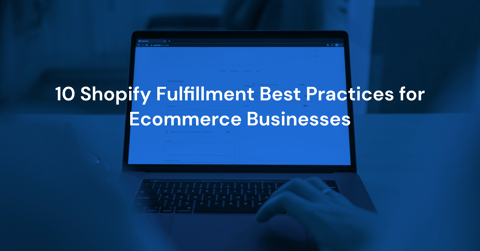10 Shopify Fulfillment Best Practices for Ecommerce Businesses

A successful Shopify ecommerce business not only drives sales but also delivers a seamless fulfillment experience. Efficiently managing products throughout the supply chain is critical to meeting evolving customer expectations.
Let’s unpack ten best practices for Shopify fulfillment that your ecommerce business needs to know.
1. Optimize Shopify inventory management
Accurate inventory management provides customers with reliable delivery dates, optimizing your fulfillment process. While Shopify offers native inventory tracking, it may not work for enterprise ecommerce businesses, especially those fulfilling orders across multiple locations.
A robust system for managing your product inventory enables real-time stock updates and accurate demand forecasting, helping you:
- Streamline processes
- Reduce errors
- Prevent overselling or stockout
Implement a solution that integrates with all your existing systems (OMS, WMS, TMS). This approach will facilitate automation, improve customer experience, and provide data that helps inform business decisions.
2. Streamline Shopify order processing
As your volume of online orders grows, you need streamlined Shopify order management, especially when optimizing time in transit. Fine-tuning your order processing workflow reduces delays and improves overall efficiency. Start with:
- Automated order routing: Set up rules to assign customer orders to fulfillment locations based on inventory availability and shipping destination.
- Batch processing techniques: Group similar orders together for more efficient picking, packing, and shipping.
- Integrations with enterprise APIs: Use robust APIs to handle high-volume order processing and real-time data exchange between systems and tools.
3. Choose the best fulfillment services for Shopify
Properly orchestrating your orders so that they ship from the right place at the right using the correct shipping method is a central process that affects timelines and drives costs for both you and your customers.
These are two key considerations when selecting the best fulfillment services for Shopify:
- Inventory placement: Distribute stock across fulfillment centers to minimize shipping distances. Take into account regional demand, seasonal trends, and shipping zones to adjust inventory allocation and reduce delivery times.
- Carrier selection: Choose the most suitable carriers based on package characteristics, destination, speed, and cost.
Using a shipping platform like Shipium can help simplify this process. Our Fulfillment Engine maps all the locations in your Shopify fulfillment network, analyzing shipping costs and delivery times to determine the most cost-effective way to distribute and ship the order — reducing your parcel spend by at least 10%.
4. Improve Shopify packaging efficiency
Choosing the proper packaging for your Shopify shipments impacts consumer satisfaction and your bottom line. Proper-sized boxes can reduce per-package prices, improve warehouse operations, and speed up order processing. Poor packaging choices, on the other hand, can damage products and increase returns, affecting customer loyalty.
Enhance your Shopify packaging processes by:
- Using the right-size packaging to reduce dimensional weight charges.
- Standardizing package sizes to improve warehouse space utilization and maximize truck capacity.
- Balancing protection and efficiency by choosing packaging that prevents damage while avoiding excess materials.
Learn how to optimize cartonization and lower shipping costs with Shipium's Packaging Planner API.
5. Offer multiple Shopify shipping options
Consumers value the availability of choices. Providing diverse shipping options lets customers pick delivery methods that work best for them. For example, they may be willing to wait a little longer for their product if that means saving on Shopify shipping. This flexibility reduces cart abandonment rates and increases the likelihood of completed purchases during checkout.
Consider these factors when optimizing your strategy:
- Domestic and international carrier network: Ensure that your shipping carrier mix includes nationwide players capable of supporting orders within US borders and globally, streamlining your fulfillment process. In the case of international shipping, provide a more economical option, like sending without tracking, along with the fastest option.
- Configurable shipping: Allow customers to make critical decisions that affect time-in-transit themselves. For example, give them the option to split an order to get in-stock items faster if one of their items is in a farther warehouse or pay a premium to reduce shipping time.
6. Prioritize ecommerce customer experience
Any overarching Shopify ecommerce fulfillment strategy should prioritize providing a positive overall experience to your customers, from purchase decision to final delivery. A seamless experience can foster brand loyalty and recommendations, while a negative experience, whether the result of sluggish shipping or lack of transparency, can result in a dissatisfied customer switching to a competitor.
Ensure your customers remain positive brand ambassadors with:
- Estimated delivery dates: Provide upfront shipping timelines for all your delivery options before customers click the buy button. Accurate delivery promises improve your average conversion rate by up to 6%.
- Order status notifications: Keep customers in the loop throughout the shipping process to minimize unnecessary customer service inquiries.
- Proactive shipping updates: Notify customers immediately and manage their expectations accordingly If shipments hit snags along the way, whether unexpected delays due to lost merchandise or natural disasters.
7. Implement efficient Shopify returns management
How effectively does your business process customer returns? With the average return rate for ecommerce reaching 17.6% in 2023, according to a report by the National Retail Federation, it’s clear that not having a well-managed system for returns can affect your bottom line. A smooth process boosts repeat business and builds consumer confidence. Here’s how:
- Centralize the returns process: Implement a unified system that tracks returned items throughout their journey, assesses their condition upon arrival, and guides decisions on refunds, exchanges, or repairs.
- Analyze returns behavior: Use data to uncover patterns and trends in customer returns. These insights can influence improvements in product design, marketing strategies, and customer service.
- Optimize operations: Leverage data-driven automation to speed up processing times and minimize costs associated with returns. Examples include intelligently routing returns to the most appropriate location or identifying opportunities for restocking.
8. Leverage data and analytics
To continually improve the efficiency of your entire ecommerce supply chain, you need a clear picture of its performance. For a data-driven Shopify fulfillment, you need to track and understand:
- Network performance metrics: Assess overall shipping efficiency across your distribution network. Track factors like processing speed, delivery times, and overall fulfillment performance to identify areas for improvement.
- Carrier mix analysis: Evaluate the distribution and effectiveness of your shipping partners. Examine how your carriers handle shipments across regions and package types to enhance your carrier selection.
- Origin performance reporting: Compare the efficiency of your warehouses. Analyze processing times and carrier utilization metrics to enhance performance at each location.
With a solid understanding of your historical performance, you can harness predictive analytics to forecast and plan for the future. Tools like Shipium Simulation leverage machine learning to help you visualize how potential changes might affect your shipping operations, enabling you to adjust your processes for optimal performance proactively.
9. Integrate with multiple sales channels
Your business can tap into a broader customer base by offering products across various platforms, from online marketplaces and physical stores to social media and mobile apps. This multichannel approach boosts sales potential, enhances the shopping experience, and increases brand exposure.
When adopting multiple sales channels, keep in mind:
- Omnichannel stock sync: Maintain real-time inventory levels across all your sales platforms. This synchronization ensures customers see accurate availability, regardless of where they shop.
- Order management across platforms: Combine order processing from various sales channels into a single system. This integration speeds up your fulfillment and simplifies how you track orders.
- Unified reporting and analytics: Consolidate data from all sales channels to gain comprehensive insights, enabling everything from better inventory planning to marketing strategies.
10. Prepare for retail peak seasons
For ecommerce businesses, peak retail season means surges in traffic, sales, and shipping. Without proper preparedness, you leave yourself open to lost opportunities, operational overload, and increased shipping rates due to reliance on premium services to keep your delivery promises.
As you head into peak season, focus on:
- Seasonal inventory planning: Forecast demand based on historical data and current trends to avoid stockouts and overstocking. Consider using predictive analytic tools to manage your inventory strategically.
- Carrier volume limits management: Factor in the capacity of your network's carriers. Having multiple carriers in your mix can help spread the load and mitigate risks of delays or cutoffs.
- Peak surcharge handling: Adjust your strategy to consider additional carrier costs during peak seasons. One approach is to offer customers alternative shipping options to balance speed and cost.
Adopting flexible technology into your Shopify shipping operations enables quick adjustments to meet increased seasonal demand. For instance, a Shipium customer shifted their holiday strategy from prioritizing cost-effective shipping from November 15 to December 15 to prioritizing Christmas Day delivery from December 16 onward. Shipium's API-first approach facilitated this quick pivot without extensive developer intervention or system overhaul.
Optimize your Shopify ecommerce fulfillment with Shipium
With Shipium, you get an end-to-end platform that unifies your existing systems and streamlines your shipping process, helping you reduce your delivery times and costs. By leveraging our suite of services, including our Fulfillment Engine and Carrier Selection, you can enhance your customer experience and drive brand loyalty.
Schedule a demo today and discover why Shipium is the best solution for Shopify fulfillment.

Diagonal thinker who enjoys hard problems of any variety. Currently employee #5 and the first business hire at Shipium, a Seattle startup founded by Amazon and Zulily vets to help ecommerce companies modernize their supply chains. Previously was CMO at Datica where I helped healthcare developers use the cloud. Prior to that I came up through product and engineering roles. In total, 18 years of experience leading marketing, product, sales, design, operations, and engineering initiatives within cloud-based technology companies.


